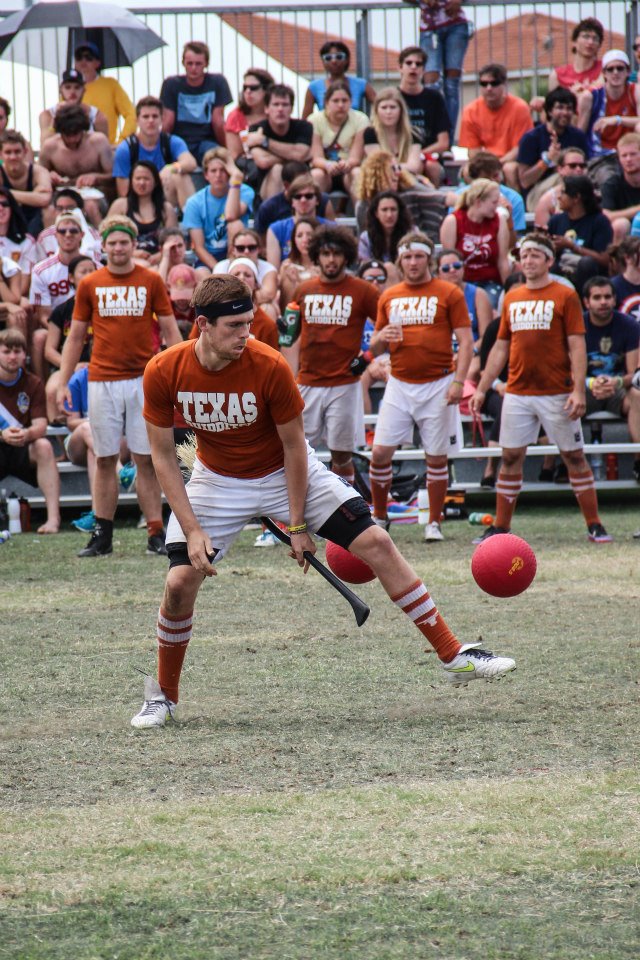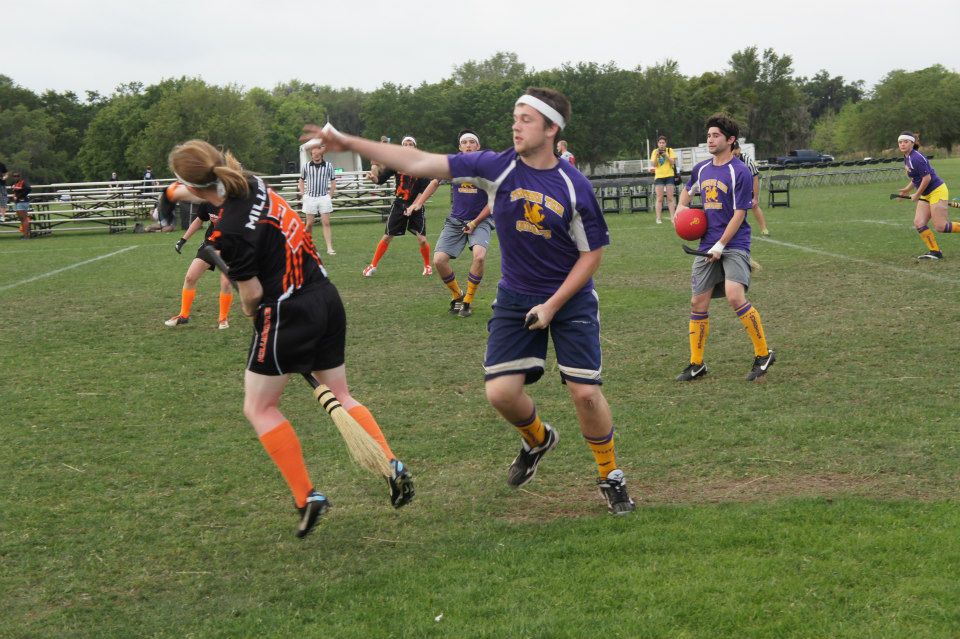- Rule, Britannia, no more?
- Unpopular Opinions: US Quadball Cup 2023
- Proven Contenders: University of Virginia
- Proven Contenders: Rutgers University
- Proven Contenders: University of Michigan
- Proven Contenders: Creighton University
- Different Perspectives: A Look Inside USA Ultimate
- Antwerp QC, Much of Belgian Core, Leaves Competitive Quidditch
World Cup Thoughts
- Updated: May 25, 2013

It has now been over a month since the World Cup. In that time, we’ve had a chance to separate ourselves from the emotion, the heat, and the awful Orlando water, making this the perfect time to look back. With 154 games on the Div. I level played over the course of two days, there is plenty to reflect on. Here are some general thoughts about the best weekend of quidditch in our sport’s young history.
The Best Team Won
This is far from an unpopular opinion. Anyone with eyes could see that the way Texas took care of business was nothing short of domination. But many will blindly attribute that to Texas simply being the biggest and most athletic team. However, a closer look reveals that to be far from the case. Courtesy of Jacob Adlis, the average height of males on the Texas team is almost exactly at the national average, while the average weight is well below.
So where did their sudden success come from? Remember, this is a team that had yet to win a tournament that either Texas A&M or Baylor attended all season, but that suddenly won nine straight games on the sport’s biggest stage without having a single one decided by a snitch pull. Much of it, as Mollie Lensing pointed out yesterday, came from execution. Texas’ play on the field was seamless, particularly their pass-and-shoot game. They might have had as many alley-oops as the other 59 teams in the tournament combined, and this all came from perfect spacing, perfect recognition, and total trust. The Longhorns were the only one of the Southwest’s big three to play in the spring semester, traveling to Louisiana for the Mardi Gras Cup, and the extra work paid off big time.
While all of that is well and good, I don’t think Kody Marshall and Augustine Monroe cutting through defenses to the hoop or finding an open Sarah Holub for a catch-and-shoot was what changed so rapidly in recent months and brought Texas such success. Honestly, the person I believe deserves the most credit is Colin Capello. Somewhere along the course of the weekend, he and Lauren Carter became the most dominant beater duo in the tournament, and that’s when the tides turned and Texas became the undisputed best team.

Colin Capello expertly navigated the bludger control game with his defensive throws back towards his own hoops. Credit: Lauren Carter
Much of the tape on the Longhorns shows them playing with both beaters back at the hoops, especially when they had bludger control. Early in the tournament, Capello adjusted to the amount of long shots being taken by playing further up the pitch, where he was more isolated and in more danger of losing bludger control. Instead of struggling, he thrived there, dominating almost every beater game the entire weekend. The difference-making factor in their complete trashing of Texas A&M in the quarterfinals was the fact that they barely gave up bludger control for a minute the whole game. Capello capped it off by outplaying UCLA’s Asher King Abramson, who many believe to be the current best in the game, in the finals.
Be Wary of Small Sample Sizes
This isn’t to say you should discount Texas’ win; the way they dominated makes me think they would have won that World Cup nine times out of 10. It’s also safe to say that UCLA, who also didn’t have a single game decided by snitch grab, including a 160*-40 beating of Bowling Green in pool play, would have likely been right alongside them in the finals. However, there are other final standings that you need to put in perspective based on the circumstances surrounding them.
Take the University of Miami, for example. The Hurricanes dominated arguably the toughest pool in the tournament, with only one game decided by snitch grab, and still managed to lock up the No. 3 overall seed. They then ran into a hot Bowling Green team, and we all know what happened from there. I didn’t watch that game live, and I am not going to comment on who should have won the game. It very well could have gone the other way, and just like that Miami is a Final Four team getting the praise they’d probably very much deserve, while Bowling Green would be out in the Round of 32 and wouldn’t be talked about to the extent that they are. I’ve been on the Bowling Green bandwagon for as long as anyone; I only mean to show that Miami, because of one unfortunate loss, should not be looked at as anything less than a top-10 team.
Northern Arizona University could also be considered in the small-sample-size lens. They topped the strangest, and perhaps weakest, pool in the tournament largely on the back of the old Middlebury formula: keep it close and bank on excellent seeking, in this case the phenomenal Porter Marsh. They then took on the Silicon Valley Skrewts in the round of 32, and won on a game that also had controversial snitch play. They then got help from Arkansas, who beat a Hofstra team that controversially had star beater Alex Leitch receive two yellow cards in the opening minutes. With the top seed in their pod gone, Northern Arizona used another snitch grab to make the Elite Eight.
There is no doubt the NAU deserved more credit than they got coming in, and their seeking game is going to make them a threat in any single-elimination tournament. But I don’t think anyone should be arguing that they are a top eight team when their best win on the weekend was against either the University of Ottawa or Arkansas.
Bludger Refereeing Still has a Way to Go
Refereeing at this year’s World Cup was a significant step up from past iterations. While I’ve seen tournaments with better refereeing, mainly regionals where many referees came from other regions and there were fewer fields, the officiating at World Cups V and VI was like night and day. Head referees are more confident and more capable than ever before, while snitch referees, facing an almost impossible job, improved by leaps and bounds. Jake Hines, who I had the chance to work with multiple times on Sunday and who prides himself in that area, was especially good officiating snitch play, and definitely deserves recognition.
All of that being said, bludger refereeing is lagging behind. Much of what made the head referees look so good on Sunday was the capable bludger referees that had their back. But while they greatly tightened up quaffle play, officiating bludger play remains questionable.
To be a good beater, more than in any other position, you need to live in a grey area of legality. This comes from years of either non-existent or lackluster bludger refereeing, which allows beaters to get away with much more than chasers do. Even as the officiating tightens up, the beaters haven’t yet adjusted.
Unfortunately, this has created a world where games are decided by how on top of beater play the bludger referees are. As I mentioned earlier, Alex Leitch, who is known for walking the edge, got caught, and ended up with a double yellow card that led to his team’s elimination.
On the other hand, you have Texas’ Colin Capello in the semifinals. Let me set the scene: Texas leads Bowling Green 30-10 more than five minutes in, but the Falcons have retained bludger control throughout, and are keeping it close because of this. Check out what happens next at the 2:05 mark of the video, and then see the slow-motion replay directly after.
Right in the middle of play, Capello levels Chad Brown from behind. It was a blindside hit, with initial contact from behind, and with Brown down and briefly shaken up, it led to an immediate change in bludger control. The Longhorns scored on two straight possessions, and suddenly the game was all but over.
Let’s break this play down: a Texas beater is holding one bludger by their hoops, standing alone. Joe Pavlik is chasing down another bludger off pitch, also uncontested. There are four bludger referees, and literally nothing else to look at. Even if someone was focusing on quaffle play, the hit happened mere feet away.
I didn’t do this to make Capello out to be a criminal – as I said, this is something that is part of being a beater. I didn’t do it to call into question the abilities of these specific referees, as this is something that happened regularly all over. Referee Development Team plans to have specific bludger refereeing training next year, and it couldn’t come sooner, so we never have to see such a big moment in a huge game play out illegally.
Strategy is Still Extremely Underdeveloped
For much of its existence, quidditch has been a game of hero ball. A team’s best player tried to go through the opposing defense by himself every possession, and usually would either get beat or score. This year, strategy has made inroads, from the University of Southern Mississippi’s blob formation that earned them a shocking top four finish at South Regionals to Baylor’s zone defense, which helped vault them to among the sport’s best.
But the World Cup helped show how much room there still is for innovation. Take Bowling Green, one of the few elite teams to use a two-male beater set the majority of the time. What this allows the Falcons to do is compete with you on a different level. Instead of matching up strength for strength and losing out to bigger, harder-hitting teams, Bowling Green creates an advantage in the bludger game and rides that to success.

Katie Milligan picks out Meredith Taylor for a pass. The talent of the pair helps Bowling Green to regularly run two female chaser sets. Credit: Hilary Barker
On the back of this strategy, Bowling Green was the only team all weekend to take bludger control from Texas for a significant period of time, and this strategy kept them close. Tufts also utilized a two-male beater set against Texas on Saturday, and were down 50-30 nearly eight minutes into the game. UCLA, of course, also deserves mention for switching to this set at times.
Then there’s the Baylor zone, which helped the Bears allow the second-fewest quaffle points in amongst all Div. I teams (Texas was No. 1). Maybe it isn’t the most effective defense once teams have played against them, but those from other regions didn’t have time to adjust, especially on Sunday when matchups weren’t predetermined and were scouting-friendly. The result was a tough-to-break defense and a trip to the semifinals.
Not all strategies are going to be successful, but just the novelty of them in a sport with so little of it can lead to success. This season defined the athleticism of the sport; I expect next year to define the strategy.
The Ten-Minute Floor Works
I have made no secret of my preference for the longer seeker floor. If you need a refresher of my rationale, check it out here.
Luckily, we ended up with the 10-minute seeker floor for World Cup, and the result was a tournament where teams had the time to go out and show what they were capable of. Only four games in all of pool play went less than 13 minutes, with three of those, interestingly enough, occurring in the same pool.
Meanwhile, the critics’ fear of games going too long because of the longer seeker floor fell flat on its face. Only two games in all of pool play went more than 30 minutes, and Saturday ran almost flawlessly along with the schedule, with Sunday only delayed due to the need to constantly adjust referee and snitch schedules as results came in.
Throughout the weekend and in the time since, I have not heard one complaint about the seeker floor. So sorry, seekers, but I feel you’ll be standing on the sidelines for at least 10 minutes for the foreseeable future.




10 Comments